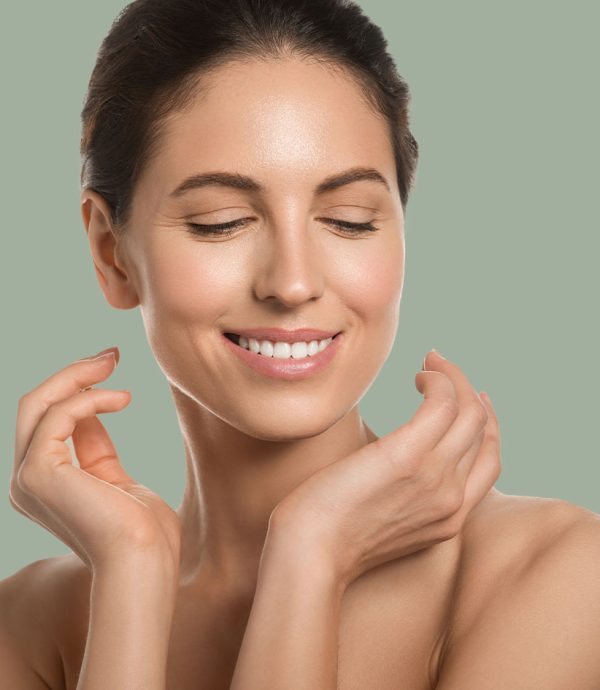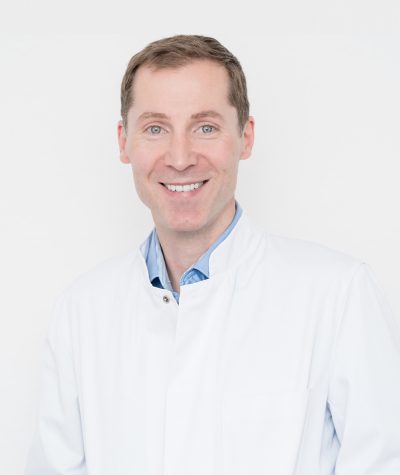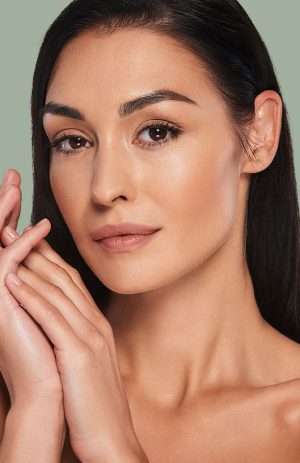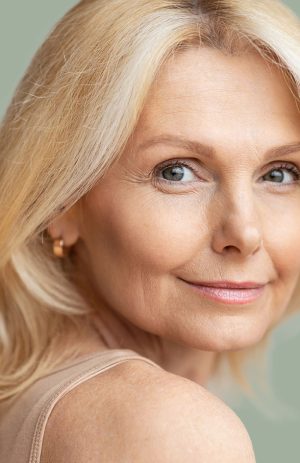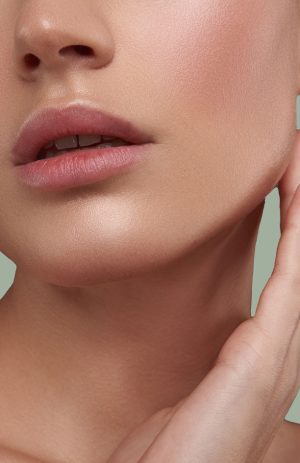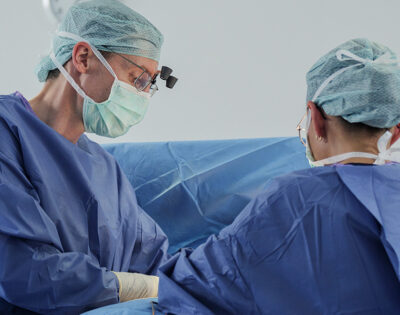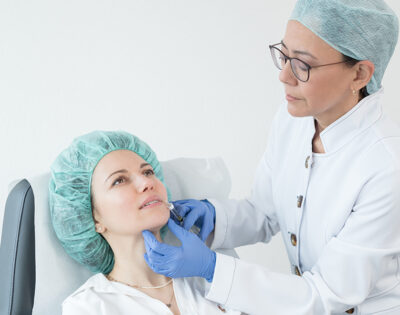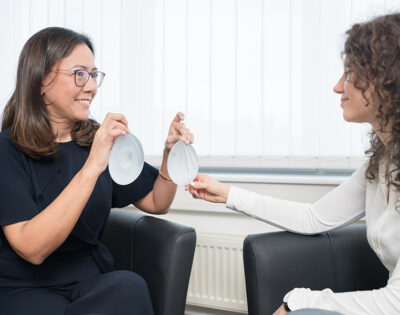Face lift (facelift): Facelift options
Every year, around 400,000 people worldwide undergo a facelift to rejuvenate their face 1 . Facelifts have been performed in Germany and the USA for over a hundred years 2 3 . The techniques are constantly being refined. Today’s techniques are characterized by natural and lasting results and very inconspicuous scars. The techniques are categorized according to the depth of the layer at which the tissue is loosened and tightened. As English is the dominant scientific language, the techniques have English names. A distinction is made between the following techniques:
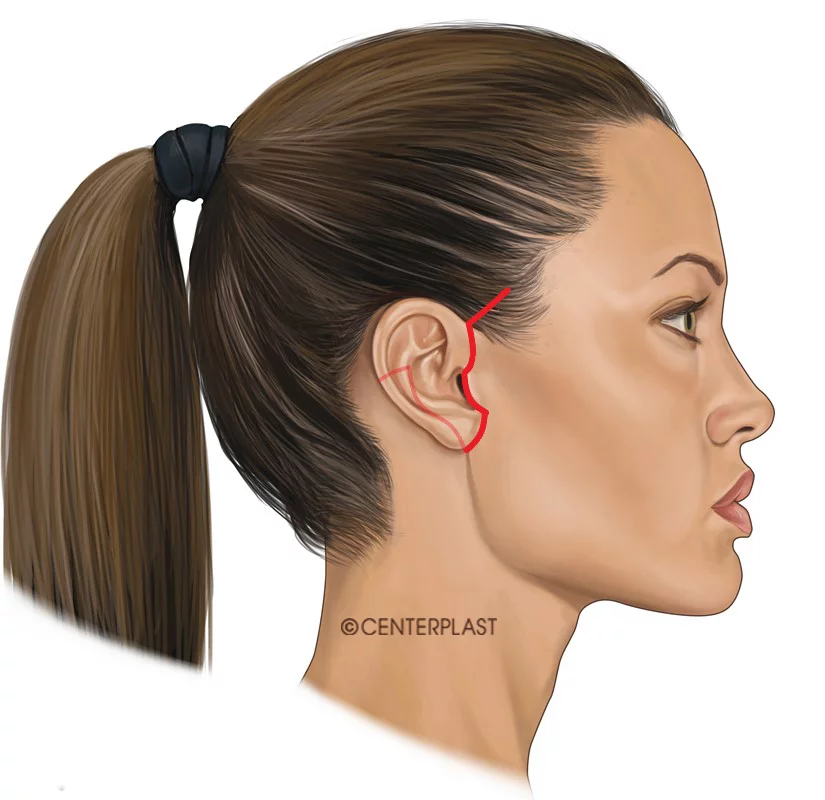
- The Mini facelift
- The SMAS Plication
- The SMAS Ectomy
- The extended SMAS facelift
- The Midface Lift
- The MACS Lift
What our patients say
Information at a glance
Operation duration
4-6 hours
Aftercare
6 weeks
Anesthesia
Twilight sleep
Thread tension
Self-dissolving threads
Hospitalization
Outpatient
Socially acceptable
after 2 weeks
Costs
Additions or alternatives
Wrinkle injection with autologous fat / Skinbooster / Microneedling
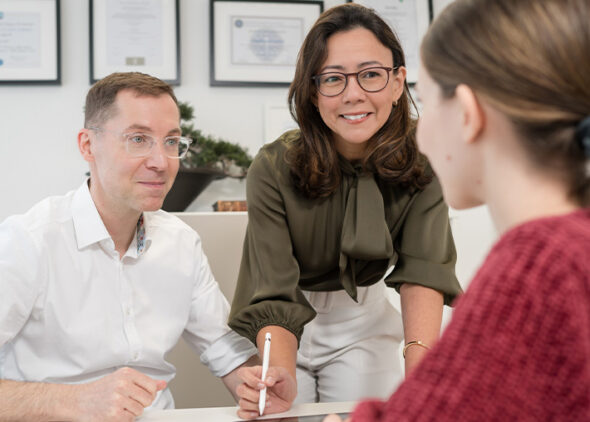
How do the facelift
Methods for face lifting
In the following sections, we would like to give you a rough idea of how the lifting techniques differ. The figures are estimates, as there is no exact scientific data available. The following distinctions are possible:
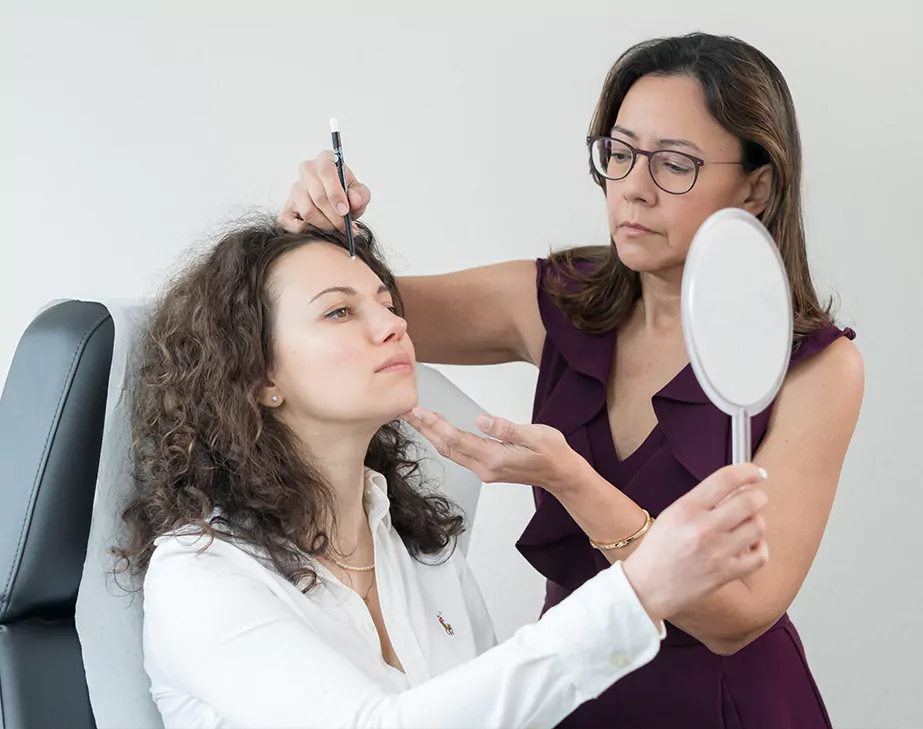
The recovery time it:
Recovery time covers many different areas. When can I eat and drink after facelift surgery? When can I shower? When can I do sport? When can I go back to work? How long does the swelling last? When is scar healing complete? Our guide values refer to the earliest time at which you can carry out your daily activities.
The duration of surgery :
Every surgical procedure involves many processes that need to be scheduled: Entering the operating room, the administration of sleeping pills by the anaesthetist, gentle positioning of the patient, injecting a local anaesthetic (anaesthetic solution), dressing the wound, post-operative monitoring and the post-operative discussion with the plastic surgeon. To simplify matters, we give you a rough estimate of the time from the time of the skin incision to the fine suturing of the wound.
The duration of action:
How long does the result last? The changes after a facelift are usually permanent. Nevertheless, no operation in the world can stop time. As a rough guide, this refers to the period during which you will look noticeably younger. How long the results for your more youthful appearance last also depends on your individual lifestyle habits (cigarette smoking, sunbathing, sleeping habits, daily skin care).
The efficiency :
How many years younger will I look? With the help of artificial intelligence, algorithms (FacePlusPlus, Amazon, Microsoft, IBM) can estimate a person’s age based on a facial photo. Studies show that the age determination of the algorithms is relatively reliable 4 . The effect can also be determined on the basis of the perceived age of those affected. Since the patient’s judgment is ultimately decisive, we quantify the rejuvenation effect as a range of the evaluation of algorithms and patients.

Lifting procedure
Mini facelift
The mini-facelift or mini-facelift is a superficial face lift (subcutaneous face lift). The superficial facelift is the oldest surgical technique for facelifting. With this technique, the layer of tissue immediately beneath the skin is loosened. During a superficial facelift, the skin can be loosened to varying degrees. Exposure of the superficial tissue layer can be limited to the skin to be removed or include the cheek area. Below is a brief overview of the key data on the Minilift:
- Recovery time: 5 to 7 days.
- Operation time: 2 to 3 hours.
- Duration of effect: 4 to 5 years.
- Effectiveness of the mini-lift: 4 to 5 years younger.
- Special feature: If a higher degree of effectiveness is aimed for with a mini-lift, there is a risk of an unnatural result, a visible scar and a distortion of the auricle or earlobe.
SMAS Plication
Like facial skin, connective tissue loses elasticity with age. Between the skin and the parotid gland there is a layer of connective tissue known as the superficial musculoaponeurotic system (abbreviation SMAS) 5 . Techniques have been developed that not only tighten the skin, but also the underlying connective tissue. A plication is a suturing technique in which the layers of tissue are placed on top of each other. The SMAS plicature technique was first described in the early seventies 6 . First, the layer between the skin and the connective tissue is loosened extensively. The connective tissue layer is then tightened by plication. The tissue is shifted towards the cheekbone.
- Recovery time: 1 to 2 weeks.
- Operation time: 4 to 6 hours.
- Efficiency: 4 to 7 years younger.
- Duration of effect: 8 to 10 years.
- Special feature: The shifting of the connective tissue layer emphasizes the contours of the cheekbones.
SMAS Ectomy
This technique involves removing excess connective tissue in the area of the parotid gland. The surgical technique is therefore referred to as lateral SMAS ectomy. First, the connective tissue above the parotid gland is exposed. An approximately two centimeter narrow strip of sagging connective tissue is removed. The connective tissue layer is closed again with a suture. The removal of excess connective tissue is preferable to a tightening suture (SMAS plication) for fuller facial contours.
- Recovery time: 1 to 2 weeks.
- Operation time: 4 to 6 hours.
- Efficiency: 4 to 7 years younger.
- Duration of effect: 8 to 10 years.
- Special feature: The removal of excess connective tissue results in balanced contours for a round face shape.
Extended SMAS Lift
Unlike all other facelift techniques, the SMAS layer (SMAS connective tissue) is moved during an extended SMAS lift (also known as a superextended facelift). The technique of tissue displacement, also known as flap plastic surgery, is used in many areas of aesthetic plastic surgery and in many different variations. To bring the connective tissue below the cheek to the desired position, the tissue must be loosened. In contrast to other techniques, SMAS flap plasty involves separating the layers in two planes: between the skin and SMAS and between the SMAS and the parotid gland. In order to achieve harmonious facial contours, the connective tissue is shifted towards the temples during the SMAS facelift. The wide release of the tissue gives the lower face a youthful chin-jawline and softens deep nasolabial folds.
- Recovery time: 1 to 2 weeks.
- Operation time: 6 to 8 hours. The connective tissue must be removed with microsurgical precision.
- Efficiency: 4 to 7 years younger.
- Duration of effect: 10 years or longer.
- Special features: The SMAS-Lift technique is particularly effective for correcting sagging cheeks. The results are natural. The facial skin lies over the tightened connective tissue without any visible tension. The SMAS lift returns the fat pads in the cheeks to the position they were in when the patient was younger. The operation can be easily combined with a neck lift. In this case, it is also referred to as a face-neck lift.
Midface Lift
The midface lift is a facelift technique in which the tissue below the periosteum is loosened at a deep level. The technique is therefore also known as a deep plane facelift, composite and subperiosteal facelift. The effect of this technique is limited to the area below the eyes, also known as the midface. The midface lift is performed via a small incision on the lower eyelid, as with a lower eyelid lift. The zygomatic muscles and the upper lip elevator are detached from the zygomatic bone and upper jaw. The use of a special camera system (endoscope) is recommended to protect a cutaneous nerve that emerges from the upper jaw.
- Recovery time: 1 to 2 weeks.
- Operation time: 4 to 6 hours.
- Efficiency: 4 to 7 years younger.
- Duration of effect: 8 to 10 years.
- Special features: The effect is limited to the region below the eyes. The scar on the lower eyelid is very inconspicuous. The results are natural as the cheek fat pads are returned to their original position. The jaw contours and the contour of the neck cannot be improved using this technique.
MACS Lift
MACS stands for “minimal access cranial suspension” and is a surgical technique for face lifting that was first described in 2002 7 . The MACS lift is a surgical technique in which the layer between the skin and the SMAS connective tissue is detached. The connective tissue is tightened using a loop-shaped suturing technique.
- Recovery time: 1 to 2 weeks.
- Operation time: 4 to 6 hours.
- Efficiency: 4 to 7 years younger.
- Duration of effect: 8 to 10 years.
- Special features: The scar is quite short. The impression of fullness can be enhanced with a round face shape.
Schematic representation of important structures in a facelift
During a facelift, the sagging skin is removed and the supporting apparatus is tightened. For this purpose, a fine layer of connective tissue (superficial musculoaponeurotic system) is exposed. Sagging ligaments are cut and the deep connective tissue layer is tightened. After the connective tissue has been tightened and, if necessary, lost volume has been replaced, the excess sagging skin is removed. The green zones can be injected with tissue fillers (autologous fat or hyaluronic acid) to enhance the contours.
Other facial nerves in the image: muscle nerve of the forehead (ramus frontalis nervus facialis), muscle nerve to the upper lip (rami zygomatici nervi facialis), muscle nerve of the lower lip and chin (ramus marginalis mandibulae), cutaneous nerve (nervus auricularis magnus).
Other ligaments in the image: ligaments between the skin and bone (mandibular ligament), ligaments between the muscle and skin (masseteric ligament).
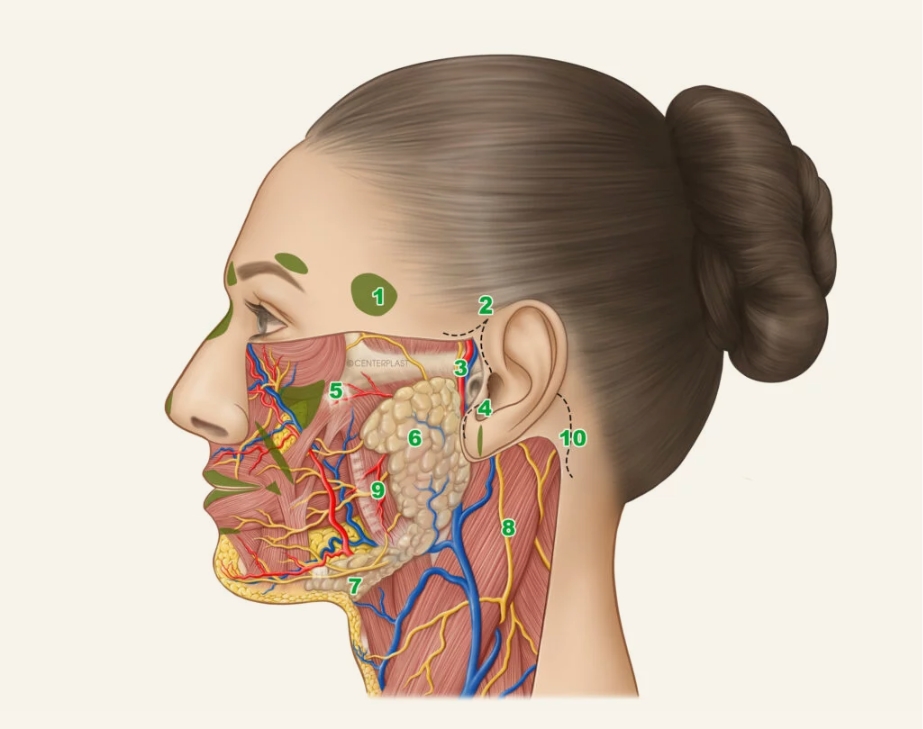
1st zone of autologous fat treatment
2. incision for a face lift
3. superficial temporal vessels (vasa temporalis superficialia) 4. elevation in front of the auditory canal (tragus)
5. ligaments between skin and bone (zygomatic ligament)
6. parotid gland (glandula parotidea) 7. submandibular gland (glandula submandibularis)
8th cutaneous nerve (nervus auricularis magnus)
9th muscle nerve to the mouth (Rami buccales nervi facialis)
10. incision for a neck lift
Facelift without general anesthesia
The aim of any anesthesia is to provide anesthesia or freedom from pain during the treatment. Preventing pain in a variety of ways achieves the greatest possible comfort. By combining different procedures, the medication can be administered in lower concentrations. As a result, side effects occur less frequently and patients recover more quickly. Thanks to modern anesthesia procedures and optimal cooperation between the anesthesiologist and the surgeon, we can offer a facelift without general anesthesia. The advantages of this special form of local anesthesia (tumescent anesthesia) and twilight sleep have been scientifically proven many times over 8 9 10 11 .
Facelift with stitches
During a PDO thread treatment, sagging fat pads on the face are lifted. The cheek contours are embellished. However, PDO threads are not suitable for the treatment of sagging skin. PDO threads do not tighten the skin. Instead, PDO threads shift the skin, like the fabric of a hood or a waistband along a cord. The PDO thread lift is reserved for patients who have good skin elasticity. PDO thread lifting is not suitable for the treatment of skin and connective tissue changes that occur after the age of 45. In these cases, the skin and supporting tissue should be treated in a targeted and differentiated manner. An SMAS facelift is an effective treatment with long-lasting effects. PDO threads are not an alternative to a facelift.
Facelift procedure

Preparation
After the personal consultation, our patients are already familiar with the surgical procedure and the preparatory and follow-up work. Nevertheless, a certain amount of residual nervousness on the day of the operation is quite normal. Dr. Santos Stahl and the anaesthetist welcome you to the clinic and check once again that the operation can take place under the best possible conditions.
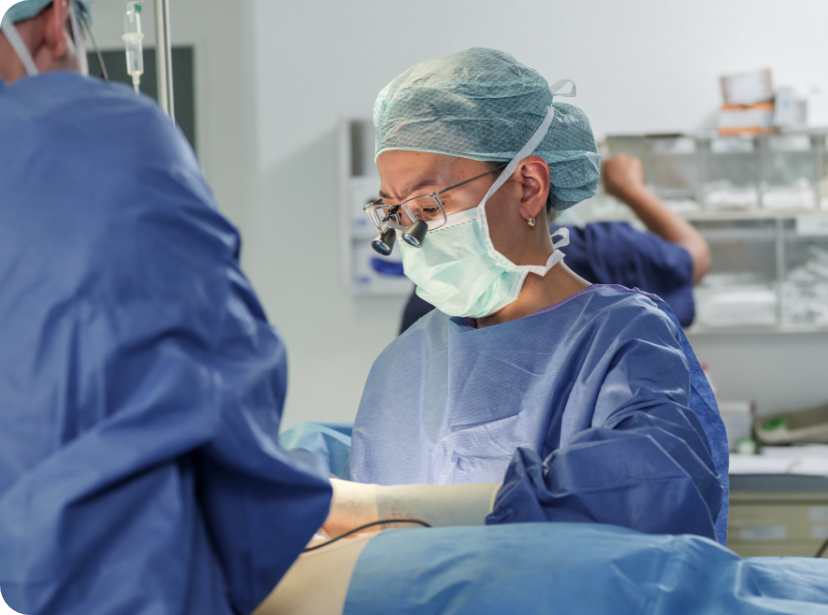
The OP
After you have changed, you will be given an antibiotic. You will then be taken to our operating theater, which is equipped with the latest medical technology. The entire surgical team will now check that all precautions have been taken to ensure your safety. The anesthetist will give you a sleeping pill and monitor your well-being throughout the procedure. The surgeon prepares the surgical field and injects the surgical area with a tumescent solution. The surgeon and assistant work with optical magnification in order to be able to operate as precisely and finely as possible.
Depending on the surgical plan, excess fatty tissue is first removed by liposuction or the patient’s own fat is treated. The soft skin layer and the connective tissue underneath are then loosened. After tightening the supporting framework of the face and neck, the excess skin is removed and finely sutured. If necessary, a microneedling treatment is carried out at the end of the operation. Finally, a sterile wound dressing and a compression mask are applied. You will then be continuously monitored in the relaxation room while you rest.
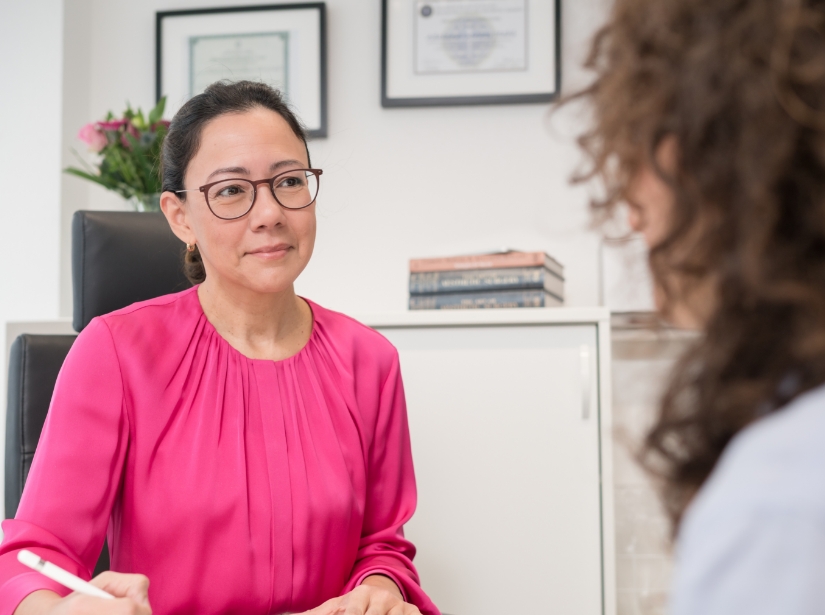
After the procedure
Before you leave the clinic, you will be given the cell phone number of your surgeon, who is always available for you. You will also receive a report on the treatment, the recommended precautionary measures and the dates of the follow-up examinations.
Advantages and disadvantages of a facelift
The traces of time can be seen more clearly on some faces than on others. Those who feel younger want to bring body and soul back into harmony. The decision to have a facelift is a very personal one. Modern aesthetic surgery offers many options that have become increasingly gentle and effective over the decades. Non-surgical treatments include microneedling, treatment with the patient’s own blood and injections. The following comparison of facelift and conservative procedures should be seen as a rough guide.
Facelift
Conservative procedures
Facelift
Rejuvenation by 4 to 7 years
Conservative procedures
Help to increase skin elasticity Increase skin thickness Reduce pigmentation spots
Facelift
Up to over 10 years, depending on the technology
Conservative procedures
Months to a few years
Facelift
2% haematoma, 1% inflammation, 0.1% nerve injury
Conservative procedures
0.004% Inflammation [13]
Facelift
7 to 14 days
Conservative procedures
None
Facelift
4 to 6 hours
Conservative procedures
30 to 45 minutes
Facelift
After 2 to 3 weeks
Conservative procedures
After 6 to 12 weeks – treatments at intervals of 4 weeks should be repeated at least 3 times
Facelift
If you want a moderate augmentation, one appointment is sufficient for a breast augmentation with autologous fat.
Conservative procedures
In the case of breast augmentation with implants, it may become necessary to change or remove the implants in the course of life.
Facelift
Changes in the breast tissue after breast augmentation with autologous fat can usually be easily differentiated from other diseases by experienced radiologists using an ultrasound examination and/or a mammogram.
Conservative procedures
After breast augmentation with implants, the U.S. Food and Drug Administration (FDA) recommends an MRI scan after three years and every two years thereafter.
Facelift for men
Facelift techniques are basically similar for men and women. However, the technical intricacies must meet men’s specific characteristics. Men have an accentuated lower jaw, a broader chin and flatter round cheeks. The skin is thicker and has a stronger blood supply than in women. The cut must take into account the beard hair and the short haircut.
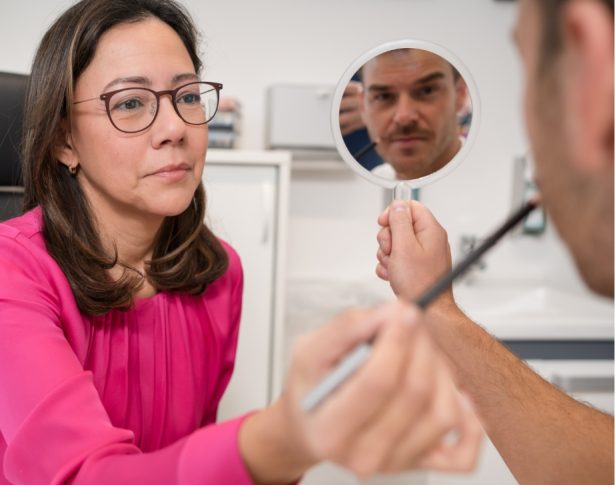
Facelift with the laser
A laser can be used to treat the surface of the skin. A CO2 laser treatment stimulates collagen production and is a useful addition to a facelift 12 . Many studies show that microneedling is comparably good at improving skin pigmentation spots and increasing skin elasticity 13 . Laser treatment can cause darkening of the skin (post-inflammatory hyperpigmentation), particularly in darker skin types. We prefer microneedling treatment to laser treatment because microneedling has fewer side effects and the recovery time is shorter 14 15 . In addition, the microneedling treatment is more sustainable. The effect of microneedling treatment can be enhanced by simultaneous treatment with the patient’s own blood. However, neither the laser nor microneedling can replace a facelift.
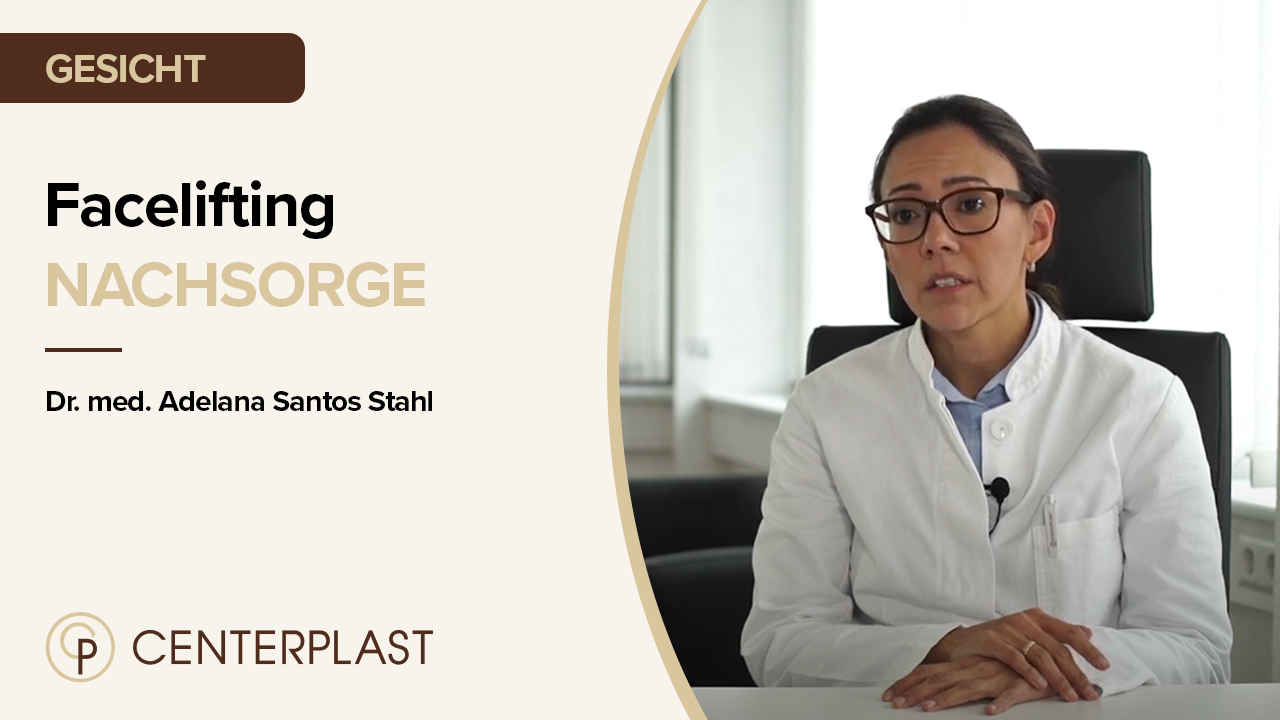
What should be considered after a facelift?
Without conscientious aftercare, even a perfectly successful operation cannot lead to an optimal result. Please note the following recommendations:
- You will be offered four appointments on site or via video consultation in the first two weeks to monitor wound healing.
- Use cooling elements or so-called migraine glasses for a maximum of 15 minutes every two to three hours during the first three days. Do not apply the face mask directly to the skin, as extreme cold can cause skin damage. Always make sure to place a compress on the surgical area before applying the cooling elements. These should only be chilled, not frozen.
- Lying down and sleeping with a light upper body (about 30 degrees) for the first five days is conducive to reducing swelling and wound healing.
- Minor pain may occur when the anesthetic wears off, usually one to two hours after the procedure. In all cases, you will be prescribed medication before the operation that you can take to prevent pain from occurring in the first place.
- If you suffer from high blood pressure, your blood pressure should be measured every two to three hours for the first five days. If the first (systolic) value of your blood pressure rises above 140 mm Hg, you should take medication to lower your blood pressure.
- If there is an increased tendency to bleed, small drainage tubes are temporarily inserted behind the ear. The drains are usually removed after 24 hours.
- The finest skin threads are removed after about ten days.
- You can shower as usual on the first day after the operation. Make sure that no soap residue remains and always dry your face with a fresh towel. In the first week, we recommend applying a wound disinfectant spray (Octenisept®) after showering.
- A previously fitted compression mask can be worn during the first week to help reduce swelling. In the second week, the compression mask only needs to be worn at night.
- You can support scar healing from the third week onwards. Apply a fat cream with as few additives as possible to the scars. Massage the cream into the skin two to three times a day for about five minutes. Protect your skin and scars with sun cream.
- Bending down, lifting heavy loads, heavy physical work and sporting activities should be avoided for three weeks, possibly longer if swelling persists. Of course, strong UV radiation (sunbathing or solarium) should also be avoided for a certain period of healing.
Facelift without surgery
As patients naturally start by finding out about alternatives to facelift surgery, they initially come across a large number of dubious advertising promises on the Internet. Dietary supplements, cosmetic products and naturopaths are not subject to the strict provisions of the Therapeutic Products Advertising Act or the professional code of conduct for doctors. It is therefore not surprising that promotional advertising for tightening facial skin with various devices, creams or even facial gymnastics is widespread online. The advertising of ultrasound devices, EMS facial muscle training (electrical muscle stimulation), radio waves or plasma pens for face lifting is misleading. There is currently no high-quality scientific study that proves a rejuvenating effect of these procedures.
Only minimally invasive aesthetic procedures such as injections with fillers and muscle relaxants can be an alternative, but these provide a temporary result and therefore need to be repeated several times. In addition, they are only effective if the signs of ageing are less pronounced (fewer deep wrinkles and less sagging skin). You can find more information on this in our category on minimally invasive treatments.
Our before and after pictures of a facelift
In the run-up to a facelift, patients want to get an idea of the possible result of the facelift. Before and after photos of cosmetic surgery may not be published on the Internet. At CenterPlast, however, you have the opportunity to view corresponding images of the entire face during the non-binding consultation appointment. The lifting images are carefully selected according to specific criteria for comparability. The before and after photos were of course taken in accordance with data protection regulations. The treated persons have given their consent to support other patients in their education. Feel free to ask us about the possibility of viewing the before and after pictures during your individual consultation.
FAQ – Frequently asked questions
Unfortunately, there is no one-size-fits-all answer to this question, as every patient has unique requirements. Even the comparison of different techniques in identical twins could not answer the question 16 . In our opinion, the method with the lowest complication rates, a significantly rejuvenating and long-lasting result is the best. The selection of the appropriate method depends on the individual skin elasticity, the shape of the face, the contour of the lower jaw and the neck. The method can also vary depending on the patient’s wishes and expectations. After examining you and discussing your goals, we will recommend a treatment plan.
The facelift costs depend on various factors. If you would like to know the price of your minor facelift or major facelift, you can now use our interactive price calculator. With just a few clicks you will receive a customized offer.
This is one of the most frequently asked questions, as patients naturally do not want any visible scars on their face. In experienced hands and with optimal aftercare, the scars after a facelift are virtually invisible. As the scars are barely visible, we recommend that you do not base your goals on the length of the scar. In principle, the incisions are made as short as possible and as long as necessary to achieve your goals. The extended SMAS facelift is more suitable for rejuvenating the jaw and neck contours than the “short scar facelift”. The scar of an “extended SMAS facelift” is insignificantly longer than the scar of a “short scar facelift”.
The scars run in the fold in front of and behind the ear. The “short scar facelift” technique is particularly scar-saving. With an extended SMAS facelift with neck lift, the scars are only a few centimeters longer. In experienced hands, the scars are barely recognizable after a few months. Certain subtleties contribute to the scars being particularly inconspicuous. These technical refinements include
- A scar in front of the tragus:
At the front entrance of the ear there is a small elevation called the tragus. The incision follows the natural contours along the fold in front of the ear. - A scar behind the tragus:
The incision is made on the inside of the tragus. After removing the excess skin, the facial skin is refined in order to optimally adapt to the contours of the tragus. The scar is not recognizable as such at this point. As a rule, this type of incision is only used on women, as the beard hair can interfere with men. - A short scar facelift:
The incision for a “short scar facelift” runs one to two centimeters above the ear, then along the front edge of the ear, below the earlobe, to a few centimeters behind the ear. The extent of the operation does not correlate with the length of the scar. The extent of a facelift is rather due to the tightening of the connective tissue under the skin. Even with a short scar, the SMAS connective tissue can be loosened and displaced. The term mini face lift is therefore not related to the extent of the operation or the result. - An extended SMAS facelift with neck lift:
Over the years, the sagging of the skin affects both the facial features and the contours of the neck. Youthful and harmonious contours of the neck are achieved with a neck lift. The surgical method is often combined with an SMAS facelift. For this purpose, the scar behind the ear is extended only a few centimeters in the area of the hairy scalp. The scar is not significantly more noticeable than the scar of a short scar facelift.
A facelift can be combined with various treatment methods. The surgical methods most commonly used during facelift surgery include
- The neck lift.
- Lipofilling.
- The upper eyelid lift or lower eyelid lift.
- A microneedling treatment.
- A skin treatment with your own blood.
- The removal of excess fat from the cheeks (Bichat fat plug).
When tightening the SMAS connective tissue, most studies assume that a younger appearance in relation to the time before the operation lasts for over 10 years 17 18 19 20 . The exact and meaningful answer to this question is complicated. There are at least three reasons for this: Not all patients can be followed up for scientific purposes ten or fifteen years after a facelift. Other factors such as cigarette smoking, physical exercise, a healthy diet, sufficient sleep, complementary treatments, good skin care and sun protection influence the ageing process and therefore the outcome of the operation. There is no single numerical value that can be used to measure the effect of a facelift. Computer algorithms can estimate the biological age of a face (FacePlusPlus, Amazon, Microsoft, IBM). Patient satisfaction, the specialist’s assessment of the overall result or the depth and number of wrinkles can be categorized on the basis of scales. Every method for assessing the effect of a facelift has certain limitations.
Individual hereditary factors and personal lifestyle habits cause us to age at different rates. Facial features and neck contours reveal our biological age. Sunken cheeks, deep wrinkles at the corners of the mouth and sagging cheeks may appear on the face. The sagging skin on the neck leads to a loss of shape and a double chin. After a facelift and neck lift, patients are considered to be younger than they are. The focus of every treatment is a beautiful, harmonious and natural result. There is scientific evidence that people mainly look at the jawline and neck to assess the age of the other person 21 .
Facelifts to improve the contours of the cheeks and to treat sagging cheeks are most commonly performed between the ages of 40 and 50. As a rule, the elasticity of the skin and connective tissue decreases between the ages of 30 and 35. The youthful contours of the jawline and cheeks fade away. The fat pads in the cheeks sink and sagging cheeks form. Depending on predisposition, lifestyle habits and pre-treatment, these symptoms may appear sooner or later. Microneedling, treatment with the patient’s own blood or injections of Sculptra® (poly-L-lactic acid) are useful treatment methods for improving skin elasticity. As a result, changes that are treated with a facelift appear much later.
You have decided to have a facelift and are already looking forward to a younger and fresher appearance. A few preparations contribute to the safety of the operation and ensure a relaxed and speedy recovery after the operation.
- Planning ahead also means allowing your body to rest and recover after the operation. Avoid binding appointments and physical exertion in the first two weeks. Do not plan any business or private air travel in the six weeks following the operation.
- If you smoke, it’s best to quit today. Tobacco cigarettes and e-cigarettes reduce blood flow to body tissue 22 . Smoking increases the rate of complications during and after surgery, as countless studies have shown 23 24 . In smokers, wound healing is delayed and the cosmetic results can be significantly worse.
- Some people suffer from mild high blood pressure, which can be treated without medication through a healthy lifestyle. Even if your blood pressure is only rarely or slightly elevated, you should have a blood pressure monitor at home to check it. After the operation, certain blood pressure limits must not be exceeded, not even for a short time. Before the operation, it is advisable to discuss with your family doctor which medication you can take to lower your blood pressure if necessary.
- Certain food supplements, vitamins and medication can thin the blood. These food supplements and vitamins include, for example: ginkgo biloba, green tea, garlic capsules, vitamin A, vitamin E, preparations with omega-3 fatty acids, echinacea, St. John’s wort preparations. To reduce the risk of bruising and bruising, these preparations should be avoided two to three weeks before the operation if possible.
- Some patients find a slightly cooling face mask pleasant after the operation. If you want to get a cooling element in advance, make sure it is as light as possible, has an ergonomic fit and a surface that can be disinfected.
- Slight wound pain may occur in the course of wound healing. You can take precautions for the time after the operation with the following over-the-counter painkillers: Paracetamol 500mg, Arnica D6 (homeopathic) 3 x 5 globules. Please read the package leaflet carefully.
- Shower or bathe as you wish in the morning before the treatment. You can help to reduce the risk of infection by cleaning your skin with a disinfectant soap (e.g. HiBiScrub® Plus by Mölnlycke, Octenisan® Wash Lotion by Schülke, Prontoderm® Shower Gel by B.Braun). Cleanse areas of skin rich in sebaceous glands particularly thoroughly. Please come without make-up on the day of the operation.
The frequency of risks depends on the extent of the operation and the patient’s state of health. The type of anesthesia can also affect the risks. The safety of our patients is our top priority. We therefore use the gentlest form of anesthesia and ensure that the procedure is performed under the best possible conditions. A facelift is a safe procedure in the hands of an experienced specialist in aesthetic and plastic surgery. The overall risk of possible complications is around five percent 25 . There is an increased risk in overweight patients, smokers, in the combination of several operations, for example on the breast or abdomen, and in operations under general anesthesia. Possible risks include post-operative bleeding (two percent), inflammation (0.9 percent), accumulation of wound fluid (0.6 percent), wound healing disorders (0.6 percent) or nerve injuries (0.1 percent). The attending physician will of course provide you with comprehensive information on this.

AUTHOR
Dr. Adelana Santos Stahl
Our aim is to offer optimal, discreet and precise treatment based on our extensive expertise in the field of plastic surgery.
Dr. Adelana Santos Stahl has a unique international perspective with a female view of plastic surgery. Your individual and detailed approach is the key to the beautiful and natural results. Having trained in Brazil, one of the largest and best-known countries for aesthetic and reconstructive plastic surgery, she understands her patients’ desire to look and feel their best.
She completed her medical studies and training as a specialist in plastic and aesthetic surgery in Brazil. In 2009, she also successfully passed the German equivalence examinations for the state medical examination.
Two years later, in 2011, she received the German and in 2012 the EU specialist certification (EBOPRAS) for plastic surgery. From 2009 to 2013, she deepened her knowledge of aesthetic and reconstructive facial surgery with world-renowned representatives of plastic surgery such as Professor Gubisch at the Marienhospital and Madame Firmin in Paris.
A VDÄPC Fellowship (continuing scholarship for graduate students) in Switzerland, France and the USA has further enriched her professional experience. Dr. Santos Stahl is active in various renowned professional associations. In addition to the DGPRÄC and DGBT, she is also a member of the Brazilian Society of Plastic Surgery – SBCP.
She is also the author of several scientific articles and, together with her husband, is dedicated to research and clinical studies in the field of plastic surgery.
She has been based in Saarbrücken since 2019.
- ISAPS Gobal Statistics 2019 ↩︎
- Miller C.C., 1907, The Correction of Featural Imperfections. Oak Printing Co, Chicago, IL ↩︎
- Lexer E. Die Gesamte Wiederherstellungschirurgie. Leipzig: Johann Ambrosius Barth Publishers; 1931. ↩︎
- Litjens G., Kooi T., Bejnordi B.E., Setio A.A.A., Ciompi F., et al., 2017, Med Image Anal. ↩︎
- Mitz V, Peyronie M., 1976, Plast Reconstr Surg. ↩︎
- Skoog T., 1974, Plastic Surgery. 1st ed. Stockholm: Almgrist and Wicksell International ↩︎
- Tonnard P, Verpaele A, Monstrey S, et al., 2002, Plast Reconstr Surg. ↩︎
- DeJoseph L.M., Pou JD., 2020, Facial Plast Surg Clin North Am. ↩︎
- Frojo G., Dotson A., Christopher K., Kaswan S., et al. 2019, Aesthet Surg J. ↩︎
- Moris V., Bensa P., Gerenton B., Rizzi P., et al., 2019, J Plast Reconstr Aesthet Surg. ↩︎
- Vitale G., Piereschi S., 2017, Ann Chir Plast Esthet. ↩︎
- de Filippi Sartori J., Osaki T.H., et al., 2021, Aesthet Surg J. ↩︎
- Emam A.A.M., Nada H.A., 2021, J Cosmet Dermatol. ↩︎
- Robati R.M., Hamedani B., Namazi N., et al., 2020, J Cosmet Dermatol. ↩︎
- Cachafeiro T., Escobar G., et al., 2016, Dermatol Surg. ↩︎
- Alpert B.S, Baker D.C., Sam T Hamra S.T., Owsley J.Q., et al., 2009, Plast Reconstr Surg. ↩︎
- Sundine MJ, Kretsis V, Connell BF., 2010, Plast Reconstr Surg. ↩︎
- Botti C, Botti G, Pascali M., 2021, Aesthet Surg J. Aug ↩︎
- Jones BM, Lo SJ., 2012, Plast Reconstr Surg. ↩︎
- Alpert B.S, Baker D.C., Sam T Hamra S.T., Owsley J.Q., et al., 2009, Plast Reconstr Surg. ↩︎
- Liao D., Ishii L.E., Chen J., Chen L.W., et al., 2020, Facial Plast Surg Aesthet Med. ↩︎
- Pywell M.J., Wordsworth M., Kwasnicki R.M., et al., 2018, J Hand Surg Am. ↩︎
- Fu R.H., Toyoda Y., Li L., et al., 2018, Plast Reconstr Surg. ↩︎
- Chopan M., Samant S., Mast B.A., 2020, Plast Reconstr Surg. ↩︎
- Chopan M., Samant S., Mast B.A., 2020, Plast Reconstr Surg. ↩︎
You might also be interested in

Personal advice
We take time for you and offer you customized advice and treatment for your individual result.
